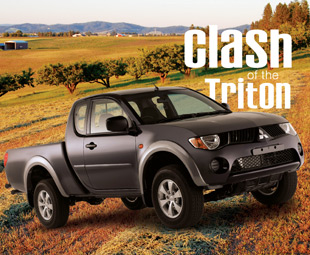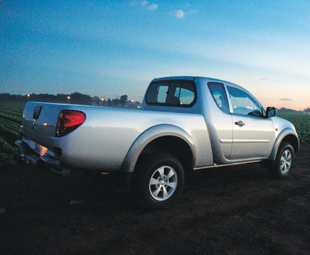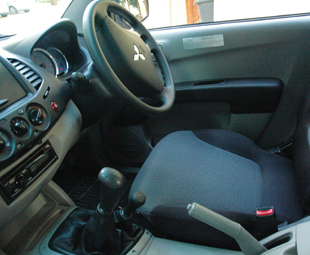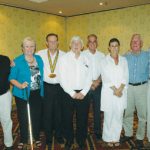Clash of the Triton

It’s not easy to find a bakkie that combines style with strength; good looks with reliability. But, as STUART MOIR discovers, Mitsubishi’s Triton ClubCab delivers the goods in all departments.
Mondays aren’t cool. They signify the end of the weekend. A long work week ahead. No fun.
But waiting in the parking lot is something that may just brighten my week. It’s the Mitsubishi Triton ClubCab and I am raring to drive it.
I know that it comes with masterful credentials: the Triton has won a bakkie-load of awards the planet over, including Pick-Up of the Year (at the UK Professional Van and Light Truck Awards). So I know it’s going to be a blast to drive.
Alas, a deadline beckons – and a demanding editor. So I trot out a couple of (even if I say so myself) brilliant articles. As fast as possible. Then I dash downstairs to meet “my” new wheels.
 Coming into first contact with the Triton ClubCab, I admire its solidly built exterior, although I have to admit that its sheer size is rather daunting (the loadbox of the latest Triton ClubCab is 14% larger than the previous model; having grown from 1 325 mm to 1 505 mm in length and gained a further 55 mm in depth). But, fearing the wrath of the aforementioned demanding editor, I hop into the cab and race off to Germiston.
Coming into first contact with the Triton ClubCab, I admire its solidly built exterior, although I have to admit that its sheer size is rather daunting (the loadbox of the latest Triton ClubCab is 14% larger than the previous model; having grown from 1 325 mm to 1 505 mm in length and gained a further 55 mm in depth). But, fearing the wrath of the aforementioned demanding editor, I hop into the cab and race off to Germiston.
Our test vehicle is the 3.2 Di-DC 4×4 manual (there are two other models in the range – the 2.5 Di-D 4×2 and 3.5 MPi Petrol 4×2) and the first thing I notice is its power steering and interior comfort; with the Triton ClubCab, it’s easy to forget that you’re driving a bakkie. Au contraire, it feels more like a sedan… but obviously one with really great ground clearance.
As I head towards the metropolis of Germiston, I’m also impressed by the Triton ClubCab’s excellent all-round vision, which makes me feel a lot safer – despite the suicidal drivers on the road. The Triton ClubCab’s full house of safety features reassures me too (the Triton Double Cab outperformed its competitors in the Euro NCAP’s first tests of “pick-up” vehicles). Thanks to the fact that blind spots are few and far between, I find it easy to remain aware of my surroundings. This range of vision complements the Triton ClubCab’s impressive manoeuvrability and the fact that the ClubCab features the smallest turning circle in its class is a huge bonus when I find one tiny, empty parking bay.
The next day, I decide to give myself and the Triton ClubCab a treat – and we head for a local 4×4 track. Once again, I discover that the small turning circle is a huge help off-road, as it means you can navigate and explore the rough while being able to adjust quickly in the face of those previously “unavoidable” objects.
The Triton ClubCab proves both capable and comfortable off-road… the latter being thanks to its front suspension, which features a double wishbone up front, replacing the previous torsion bar suspension. At the rear, the Triton ClubCab has above-the-axle type leaf springs, and I am constantly impressed by the enhanced driving comfort and good handling afforded by this combination.
Driving the Triton ClubCab off-road, I quickly realise how little exertion the big guy requires to climb over any obstacle. It has 118 kW of power on hand at 3 800 r/min and a massive 343 Nm of torque are available at just 2 000 r/min. From 2 000 to 4 000 r/min the Triton ClubCab reveals its true character, with the torque coming on nice and strong as the 3.2 l diesel motor finds its stride even quicker than one would expect. Although the Triton ClubCab has a turbo diesel engine, its clatter never intrudes into the cab. The Triton ClubCab’s acceleration is impressive too, so – out on the road – you feel like a 100 m track athlete overtaking at rapid speed without much strain.
Given the fact that this issue of FOCUS is also being read avidly by farmers at Nampo, I decide to take the Triton ClubCab to a smallholding outside Heidelberg owned by a mate’s dad. It’s a long drive… but I’m keen to test the vehicle in one of the environments for which it was intended. This excursion proves to be a tough test indeed! It had been raining the day before and, walking amongst the lettuce and spinach (sexy job this), I am soon knee-deep in mud.
 The Triton ClubCab isn’t nearly as bothered; it keeps good traction as it makes the seamless transition from wet tar to muddy sand with aplomb. Naturally, four-wheel drive is a prerequisite if I don’t want to sleep with the lettuce and spinach, but the easy-select 4WD is so simple to engage that even Homer Simpson could manage it. I pop it into four-low and soon those green leafy vegetables are history.
The Triton ClubCab isn’t nearly as bothered; it keeps good traction as it makes the seamless transition from wet tar to muddy sand with aplomb. Naturally, four-wheel drive is a prerequisite if I don’t want to sleep with the lettuce and spinach, but the easy-select 4WD is so simple to engage that even Homer Simpson could manage it. I pop it into four-low and soon those green leafy vegetables are history.
Back on the tar road again, I point the Triton ClubCab’s sculptured nose in the direction of Pretoria, and embark on a 160 km/h trip. As I drive along the highway, I am mindful of the smooth five-speed gearbox and the good gear ratios. I am also constantly impressed by its car-like drive. Yes, this is a pick-up that has been purpose-built for hard labour on construction sites and farms. But it’s also a comfortable everyday vehicle…
En route to Pretoria, I top up with diesel. Mmm. The fuel consumption is good – it has sipped just 9 l/100 km, which means it won’t overstretch my pocket or a transport operator’s either. While waiting for the tank to be filled, I inspect the interior. Nice. The shapely dash offers striking dials, while the ergonomics mean that all vital information is easily accessible. The instrument panel is especially visible at night, by the way… it’s lit by a blue glow. I pop the receipt in the stowage bin between the front buckets, which also has an integrated armrest.
Speaking of the interior, the Triton ClubCab’s seats are more than just comfortable. They also offer good support: a real plus if you find yourself behind the wheel for long periods of time (as many farmers and other transport operators do). There is adequate headroom and excellent legroom for your passenger, while the ClubCab has the extra advantage of space behind the front seat where you can store bags and other paraphernalia that would otherwise have to sit in the back of the bakkie.
Exterior features include a rear sports bar, nudge bar and side steps; and a tow bar with a towing capacity of 1 500 kg. The Triton ClubCab’s rear tailgate features a swage line, making it more resistant to soft-impact denting.
The next day, the Triton ClubCab needs to go home. Back to a local Mitsubishi dealer. I strap my bike in the loadbox and make the journey to William Nicol Drive. Handing over the keys, I’m sorry to lose my new steed. While driving the Triton ClubCab for a few days, both on and off-road, I’ve found it to be both economical and comfortable. What’s more, it certainly isn’t afraid to tackle the roughest conditions. In fact, it’s sure to make a most likeable and reliable business partner.
Published by
Focus on Transport
focusmagsa




